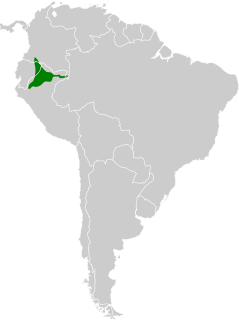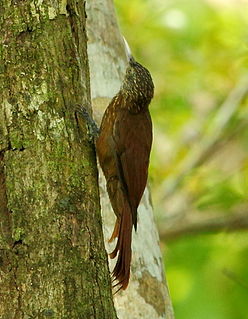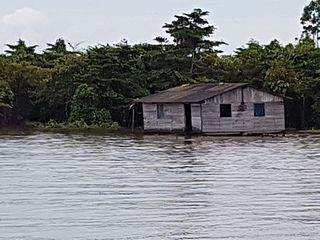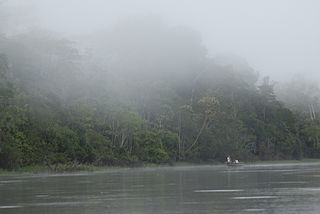| Varzea | |
|---|---|
 | |
| Varzea bistriata , two-striped mabuya | |
| Scientific classification | |
| Kingdom: | Animalia |
| Phylum: | Chordata |
| Class: | Reptilia |
| Order: | Squamata |
| Family: | Scincidae |
| Subfamily: | Mabuyinae |
| Genus: | Varzea Hedges & Conn, 2012 |
| Species | |
2 species, see text | |
| Varzea | |
|---|---|
 | |
| Varzea bistriata , two-striped mabuya | |
| Scientific classification | |
| Kingdom: | Animalia |
| Phylum: | Chordata |
| Class: | Reptilia |
| Order: | Squamata |
| Family: | Scincidae |
| Subfamily: | Mabuyinae |
| Genus: | Varzea Hedges & Conn, 2012 |
| Species | |
2 species, see text | |
The following 2 species, listed alphabetically by specific name, are recognized as being valid: [1]
Nota bene : A binomial authority in parentheses indicates that the species was originally described in a genus other than Alinea.

Mabuya is a genus of long-tailed skinks restricted to species from various Caribbean islands. They are primarily carnivorous, though many are omnivorous. The genus is viviparous, having a highly evolved placenta that resembles that of eutherian mammals. Formerly, many Old World species were placed here, as Mabuya was a kind of "wastebasket taxon". These Old World species are now placed in the genera Chioninia, Eutropis, and Trachylepis. Under the older classification, the New World species were referred to as "American mabuyas", and now include the genera Alinea, Aspronema, Brasiliscincus, Capitellum, Maracaiba, Marisora, Varzea, and Copeoglossum.

The black squirrel monkey, also known as the blackish squirrel monkey or black-headed squirrel monkey, is a small New World primate, endemic to the central Amazon in Brazil. It largely resembles the female of the far more common Bolivian squirrel monkey, though the latter lacks the black central back.

Freshwater swamp forests, or flooded forests, are forests which are inundated with freshwater, either permanently or seasonally. They normally occur along the lower reaches of rivers and around freshwater lakes. Freshwater swamp forests are found in a range of climate zones, from boreal through temperate and subtropical to tropical.
Várzea may refer to:

The varzea schiffornis, also called várzea mourner or greater schiffornis, is a species of bird in the family Tityridae. It has traditionally been placed in the manakin family, but evidence strongly suggest it is better placed in Tityridae, where now placed by SACC.

The orange-eyed flatbill or orange-eyed flycatcher is a species of bird in the family Tyrannidae. It is found in the Amazon in south-eastern Colombia, eastern Ecuador, and north-eastern Peru. First recognized as a species due to its distinct voice, it was only described in 1997; the binomial commemorates the American ornithologist Melvin Alvah Traylor Jr. The International Union for Conservation of Nature has rated the conservation status of this species as being of "least concern".

Zimmer's woodcreeper is a species of bird in the woodcreeper subfamily (Dendrocolaptinae). Its genus, Dendroplex, was recently confirmed to be distinct from Xiphorhynchus. It mainly occurs in Brazil's Amazon basin as well as in adjacent border areas of northeast Peru and southeast Colombia. Its natural habitat is Várzea.

The varzea piculet is a species of bird in the family Picidae, the woodpeckers, piculets, and wrynecks. It is endemic to Brazil's Amazon basin where it occurs in seasonally flooded Várzea forests, which gives the bird its common name. Its natural habitat is tropical moist lowland forest, and as the trees are progressively being cleared in the Amazon basin, the population of the bird is declining, and as a consequence, the International Union for Conservation of Nature has rated it as an "endangered species".

Dendroplex is a genus of bird in the woodcreeper subfamily (Dendrocolaptinae). It was long merged into Xiphorhynchus, but its distinctness was recently validated.

José Márcio Corrêa Ayres was a Brazilian primatologist and conservationist who founded the Mamirauá Sustainable Development Reserve in 1996, followed by the Amanã Sustainable Development Reserve in 1998. The two reserves are located in the central region of the Brazilian state of Amazonas, and are joined to adjacent Jaú National Park to form a corridor spanning over 20,000 square miles (52,000 km2) of protected rainforest.
A várzea forest is a seasonal floodplain forest inundated by whitewater rivers that occurs in the Amazon biome. Until the late 1970s, the definition was less clear and várzea was often used for all periodically flooded Amazonian forests.

The Japurá–Solimões–Negro moist forests (NT0132) is an ecoregion of tropical moist broad leaf forest in the Amazon biome.

The Marajó várzea (NT0138) is an ecoregion of seasonally and tidally flooded várzea forest in the Amazon biome. It covers a region of sedimentary islands and floodplains at the mouth of the Amazon that is flooded twice daily as the ocean tides push the river waters onto the land. The flooded forests provide food for a wide variety of fruit-eating fish, aquatic mammals, birds and other fauna. It has no protected areas and is threatened by cattle and water-buffalo ranching, logging and fruit plantations.

The Gurupa várzea (NT0126) is an ecoregion of seasonally and tidally flooded várzea forest along the Amazon River in the Amazon biome.

The Monte Alegre várzea (NT0141) is an ecoregion of seasonally flooded várzea forest along the Amazon River in the Amazon biome.

The Purus várzea (NT0156) is an ecoregion of seasonally flooded várzea forest in the central Amazon basin. It is part of the Amazon biome. The ecoregion is home to a vegetation adapted to floods of up to 12 metres (39 ft) that may last for eight months. There is a great variety of fish and birds, but relatively fewer mammals. Ground-dwelling mammals must migrate to higher ground during the flood season. Threats include logging, cattle farming, over-fishing and mercury pollution from gold mining.

The Purus-Madeira moist forests (NT0157) is an ecoregion in the central Amazon basin. It is part of the Amazon biome. The ecoregion covers a stretch of flat and relatively infertile land between the Purus and Madeira rivers, extending to the Solimões River in the north. It is isolated from other regions by the seasonally flooded várzea forest along these rivers, and has a high degree of endemism among its flora and fauna. The natural environment is relatively intact. The BR-319 highway was built along the length of the ecoregion in the early 1970s, but rapidly deteriorated and is now closed.

The Solimões-Japurá moist forests (NT0163) is an ecoregion in northwest Brazil and eastern Peru and Colombia in the Amazon biome. It has a hot climate with high rainforest throughout the year, and holds one of the most diverse collections of fauna and flora in the world. The ecoregion is relatively intact.

The Iquitos várzea (NT0128) is an ecoregion of flooded forest along rivers in Brazil, Peru and Bolivia in the west of the Amazon biome. The forest is seasonally flooded up to 7 metres (23 ft) by whitewater rivers carrying nutrient-rich sediment from the Andes. The meandering rivers often shift course, creating a complex landscape of oxbow lakes, marshes, levees and bars, with grasslands, shrubs and forests in different stages of succession. During the extended flood periods fish enter the forest in search of fruit. The várzea is accessible by the navigable rivers that run through it, and has suffered from extensive deforestation to extract timber and create pasture for livestock.

The Uatuma–Trombetas moist forests (NT0173) is an ecoregion in northwest Brazil in the Amazon biome. It covers the Amazon basin north of the Amazon River from close to the Atlantic Ocean to the Rio Negro west of Manaus. The ecoregion is relatively intact, although it has been damaged along the main rivers and around population centers.
![]() Data related to Varzea (lizard) at Wikispecies
Data related to Varzea (lizard) at Wikispecies